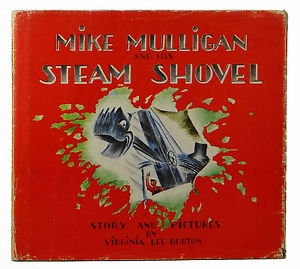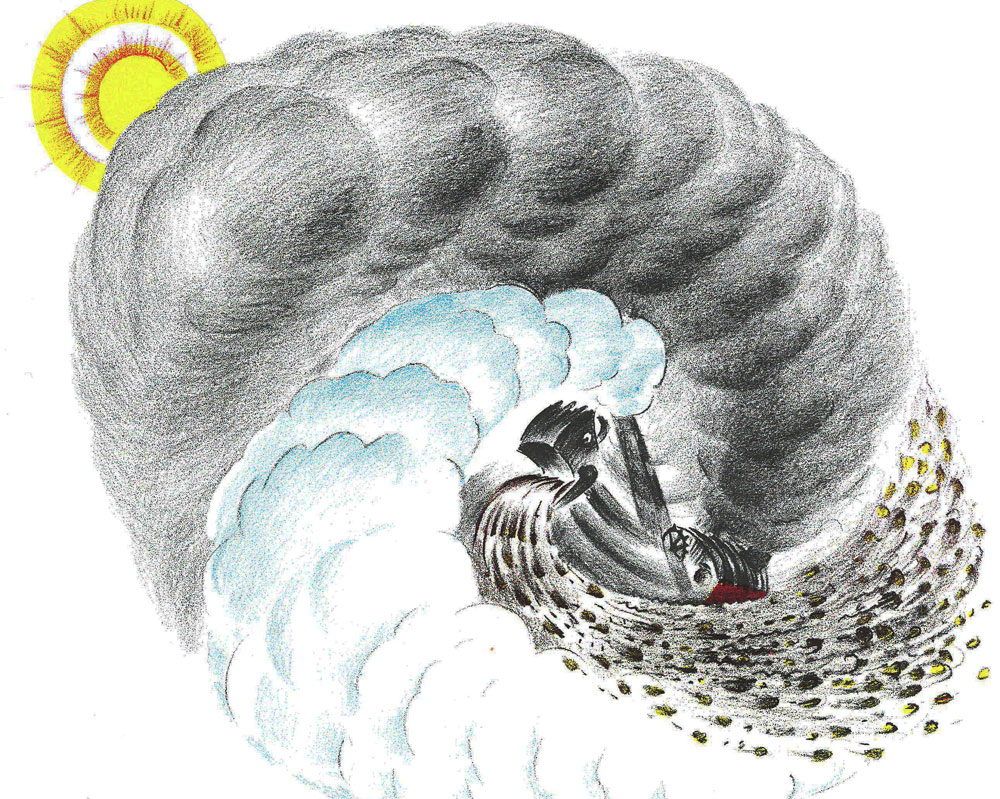
Google is upgrading health search…again.
In 2010, I was inspired by Animal Farm to write that Google saw some health sites as more equal than others. This time I turned to Mike Mulligan and his Steam Shovel, by Virginia Lee Burton.
If you don’t know the story, Mike boasts that he and his steam shovel, Mary Anne, can dig the foundation for a new town hall in just one day. He says that if they fail, the town won’t have to pay him at all. A crafty town selectman, Henry B. Swap, sees an opportunity to get part of the job done for free and “smiles in a rather mean way” as they seal the deal.
Mike and Mary Anne set to work, digging as if for their lives, gaining strength from the support of the crowd that gathers to watch.
My favorite illustration shows the swirl of dirt, dust, and steam as Mary Anne bites away at the earth:
The dust settles at sundown and Mike is at first triumphant: They did it! They dug the foundation in just one day.
But Mike had failed to plan for a way to get Mary Anne out of the hole. Again the crafty Henry B. Swap smiles in a rather mean way, savoring his victory over the upstart. It’s a disheartening turn of events.
But wait! The cynics don’t win! A little boy suggests that Mary Anne’s powerful steam engine could become the furnace of the new town hall if they build it around her.
‘Why not?’ said Henry B. Swap, and smiled in a way that was not quite so mean.
Relief floods through me even now, reading that line.
Why am I telling you all this?
Because, at their very best, I see technology companies (even a behemoth like Google), playing the roles of Mike and Mary Anne: bold, brash, and not afraid to take on audacious goals. We need that in health care.
I see establishment health care, at its worst, playing the role of Henry B. Swap – arms crossed, as if to say, “oh, you think you’re so smart,” and smiling in a rather mean way as the techies fail.
Consumers play the role of the community that comes out to watch. Some are there to cheer, some just to gawk at the spectacle, but we all hope that somehow, some day, the problems will get solved.
Note that the story is not a perfect analogy. Mike and his steam shovel, Mary Anne, represent a dying form of technology, as other bloggers point out here and here.
But try to see what I see:
Yes, Dr. Google can dump you into a sewer of misinformation.
Yes, Apple’s HealthKit can be distressingly inaccurate.
Yes, it is easy to poke holes in wearables.
Yes, IBM Watson is being fed a too-strict diet of “peer reviewed” information (scare quotes intentional).
But these companies are TRYING.
How might we help them?
Think about it: Who offers the innovative solution that saves the day in the storybook? A child. Someone outside the “we know best” adult world.
Who plays that outsider role in health care? Patients and caregivers.
For example:
- Hugo Campos, who wants access to his own heart monitor data.
- Ernesto Ramirez, who, along with his Quantified Self compatriots, takes a citizen-scientist approach to helping people understand self-tracking.
- Dana Lewis and Scott Leibrand, who are building an Open Artificial Pancreas, not waiting for the world to catch up to their vision for living with diabetes.
- Erin Moore, whose just-in-time advice to another family in her online community saved a child from unnecessary treatment.
- Emily Kramer-Golinkoff, who believes that her life depends on what she learns online from fellow patients as well as from her clinicians.
- Laura Kolaczkowski, who is helping to create a platform for people living with multiple sclerosis to share their data.
- Matthew Might and Matt Wilsey, two rare-disease dads who found each other through a Google search and are helping to create a new model for diagnosing genetic conditions.
More broadly:
- Contributors to PatientsLikeMe, Smart Patients, Quantified Self, Iodine, and other platforms for sharing insights and data.
- Contributors to the #bcsm community (and every other disease hashtag) who gather, share, and create a never-ending stream of information and support on Twitter.
What other examples do you see of quixotic quests in health and health care? Where do you see glimmers of hope? Where can we gather as a community to cheer on a team that needs a boost? How might we get people to smile in a not so mean way when people dream and ask, “What if health care…?” How might we get more people to say, “Why not?”
—————————-
Disclosure:
I’m an advisor to Iodine and Stanford Medicine X, which I mention or link to in the post.
Too good not to share:
When I searched online for images of Henry B. Swap I stumbled on a wonderful list of words we wish we had in English, such as:
Glas wen (Welsh): Literally, a “blue smile” – a smile that is insincere or mocking.
Henry B. Swap was the illustration.
I also found a video of someone reading the storybook out loud and someone who tweeted it, line by line. I love the internet.

Thank you Susannah as always for connecting the dots with clarity and humor. I’ve been interested in trying to understand the cultural meaning of the “that will never work” crowd. It’s probably a necessary and useful reaction, as you imply, to the frequent bragging and obvious overconfidence of the “disruption” crowd. As you suggest, most of this is pretty much noise, and there’s something to be gained from listening harder, and sharing examples where real work is happening – as you’ve done: it’s an honor to have QS mentioned next to the other projects you name.
Yes! We need to be practical idealists if we hope to move health care forward: skeptical, but not mean; optimistic, but not ridiculously so.
We need to listen to the signals being sent from way down deep in the organizational chart — or off the chart entirely.
My biggest struggle was choosing which people and orgs to highlight — examples are legion if you’re, let’s say, writing a book about this 🙂 I may have to start a wiki! So much great work is being done out there. This is just what’s under the spotlight today.
Thanks for the pingback, and thanks for the excellent and informative article! I have a real problem with the mass of snake-oil being peddled in our day by the likes of “Dr.” Oz (a tragic sellout, as he’s a qualified physician who for some reason drank too much Kool Ade), Mercola, and others – but that said, there’s a lot of info out there that mainstream research won’t tackle because there’s no money in it. Whenever people pooh-pooh natural remedies, I just point to Aspirin.
Oh, wow! I am so happy to have the chance to say thank you for your post. I have been madly forwarding it to friends and reading it aloud to people. My 10-year-old ate a massive breakfast this morning and asked me, “What’s that word for ‘I accidentally ate the whole thing’ again? That’s me right now.”
Shemomedjamo, btw, for those following along at home:
https://playingintheworldgame.wordpress.com/2013/01/17/words-that-we-wish-english-had/
Thank you for your continued efforts to elevate the work of individuals and small organizations to be seen as equals to the large players in healthcare innovations.
It’s humbling to be mentioned in the same space with so many great innovators of health care and visionaries of what we might create.
Our goal with iConquerMS is to create change for those of us living with Multiple Sclerosis but also to construct a worthy model that can be replicated by any other group wanting to gather Big Data for a particular health care need. Thank you for putting my name and our collective works in the spotlight.
Laura, one of my mantras is, “We all have something to learn. We all have something to teach.” Thank you for being a pioneer for MS and for health data. There is so much potential for good in our world!
Susannah,
Mike Mulligan and his Steam Shovel was my absolute favorite book as a child. During every reading, I felt a pang of sadness when the story reveals that Mary Anne was stuck in the basement. My mom always pointed out that Mary Anne’s work would live on and on in her new job as “Boiler Queen.” It was a great analogy for life – sometimes we dig and work and toil, only to realize we need to re-evaluate and re-imagine a new outcome for all our work. We haven’t lost the work, we just need to make adjustments and keep going.
Healthcare will get there. When the dust settles and the health tech and provider communities find they’ve been playing in the same sandbox as the ePatients, we’ll begin to make that progress. We just need to get there – and trust we can keep thinking outside the box.
Appreciate the kind mention of #BCSM! Thank you,
@stales
Yes, I felt the same pang, looking at Mary Anne in the basement after having seen her adventures all over the world.
Hugo Campos wrote a lovely response to my Medium post on this topic:
A call to greatness
https://medium.com/@hugooc/a-call-to-greatness-3ebdd9c3f198
And Emily Kramer-Golinkoff wrote another excellent response, about how patients are also bold, brash change-makers:
https://medium.com/@emilykg/were-the-bold-brash-change-making-hackers-too-ff50ab576c12
While I’m at it, posting all the Medium responses, I’ll note that John Grohol asked a few sharp questions in the margins:
“How is Google being brash? They ran Google Health, then shut it down. Thats hardly the sign of a company willing to take risks…. And then stay behind them just because they’re not a huge commercial success.”
I replied: “I take your point. But I like that they tried. I like that their experiment drew so many fans and detractors that the industry is still talking about it.”
John then asked: “If you take on an audacious goal & fail, is that something we should laud? Suggests they never really bothered to understand the industry to begin with. Google has long track record of retiring tools that no longer serve their business purpose. Hence the reason it’s not always a good thing to trust a technology company. They’re too quick to shut down things people use.”
And I replied: “Yes, I do think we should laud bold attempts and learn from failures. Google Health is a Rorschach test. I see arrogance, hope, broken glass, and a door left open.”
As an aside, I’ll note that John is rightfully frustrated with the tiny space given to comments on Medium. You have to write a separate “response” like Hugo & Emily did in order to really have your say.
Here’s an interesting essay about the benefits and drawbacks of posting to Medium by Melody Kramer, just in case anyone wants to think along with me about posting to various platforms:
https://medium.com/@mkramer/things-i-learned-from-publishing-a-1-piece-on-medium-5cb8f44317c6
Two of my essays have gotten “picked” by Medium to be featured on the homepage and in their daily email. I never reached #1 but both essays were in the top 10 posts for a day or two. It was fun to see a different mix of people engaging with my ideas. What Melody sees as a drawback, for example, is a plus for me: more media/design experts read Medium than follow my blog, so it was a welcome expansion of my audience.
Again, thanks so much for doing the work that inspires me! And coming to my blog to be part of the conversation.